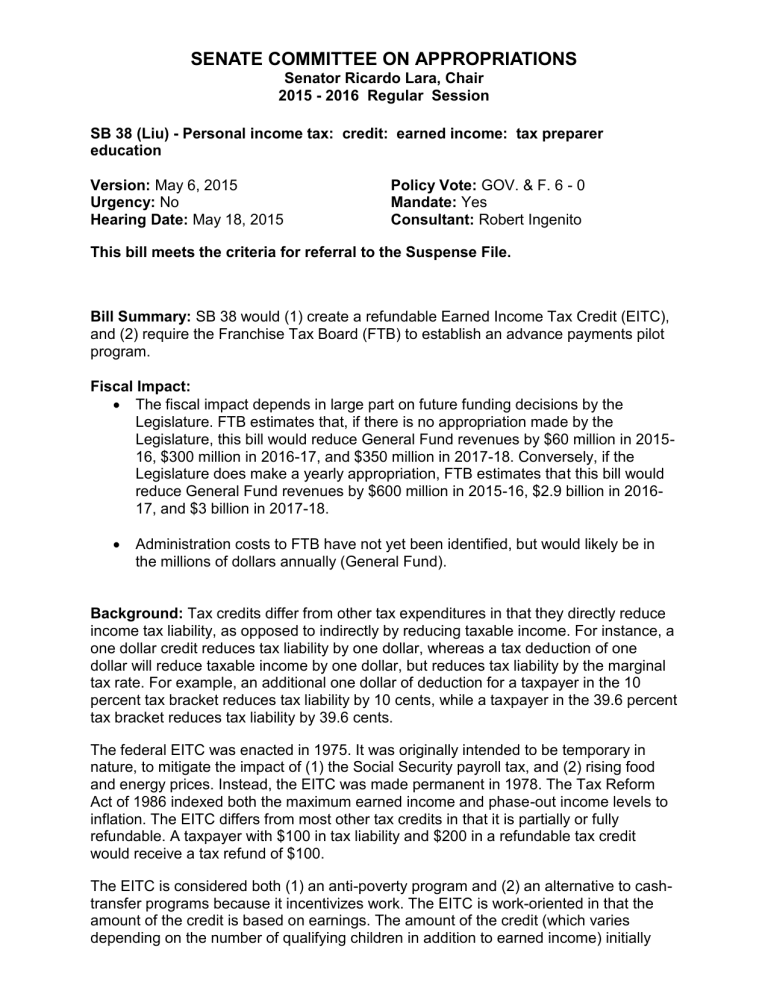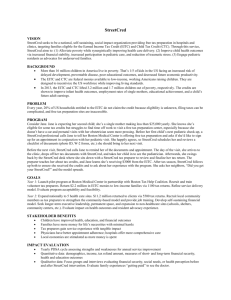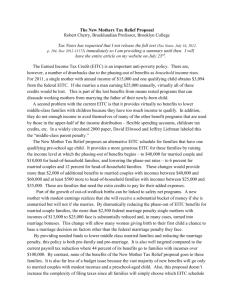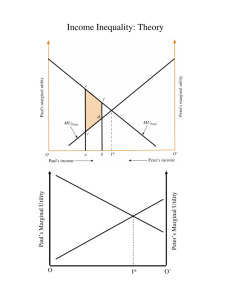Sen. Appropriations

SENATE COMMITTEE ON APPROPRIATIONS
Senator Ricardo Lara, Chair
2015 - 2016 Regular Session
SB 38 (Liu) - Personal income tax: credit: earned income: tax preparer education
Version: May 6, 2015
Urgency: No
Hearing Date: May 18, 2015
Policy Vote:
Mandate:
Consultant:
GOV. & F. 6 - 0
Yes
Robert Ingenito
This bill meets the criteria for referral to the Suspense File.
Bill Summary: SB 38 would (1) create a refundable Earned Income Tax Credit (EITC), and (2) require the Franchise Tax Board (FTB) to establish an advance payments pilot program.
Fiscal Impact:
The fiscal impact depends in large part on future funding decisions by the
Legislature. FTB estimates that, if there is no appropriation made by the
Legislature, this bill would reduce General Fund revenues by $60 million in 2015-
16, $300 million in 2016-17, and $350 million in 2017-18. Conversely, if the
Legislature does make a yearly appropriation, FTB estimates that this bill would reduce General Fund revenues by $600 million in 2015-16, $2.9 billion in 2016-
17, and $3 billion in 2017-18.
Administration costs to FTB have not yet been identified, but would likely be in the millions of dollars annually (General Fund).
Background: Tax credits differ from other tax expenditures in that they directly reduce income tax liability, as opposed to indirectly by reducing taxable income. For instance, a one dollar credit reduces tax liability by one dollar, whereas a tax deduction of one dollar will reduce taxable income by one dollar, but reduces tax liability by the marginal tax rate. For example, an additional one dollar of deduction for a taxpayer in the 10 percent tax bracket reduces tax liability by 10 cents, while a taxpayer in the 39.6 percent tax bracket reduces tax liability by 39.6 cents.
The federal EITC was enacted in 1975. It was originally intended to be temporary in nature, to mitigate the impact of (1) the Social Security payroll tax, and (2) rising food and energy prices. Instead, the EITC was made permanent in 1978. The Tax Reform
Act of 1986 indexed both the maximum earned income and phase-out income levels to inflation. The EITC differs from most other tax credits in that it is partially or fully refundable. A taxpayer with $100 in tax liability and $200 in a refundable tax credit would receive a tax refund of $100.
The EITC is considered both (1) an anti-poverty program and (2) an alternative to cashtransfer programs because it incentivizes work. The EITC is work-oriented in that the amount of the credit is based on earnings. The amount of the credit (which varies depending on the number of qualifying children in addition to earned income) initially
SB 38 (Liu) Page 2 of rises as earnings increase, then reaches a plateau, and then falls as earnings increase
4 further. For example, for a couple with two children in 2014, the credit is equal to 40 percent (the credit rate) of the first $13,700 in earnings. The maximum credit of $5,460 is received by taxpayers with earnings between $13,700 and $23,300. The credit phases out at a rate of 21.06 percent (that is, it is reduced by 21.06 cents for every additional dollar of earnings) for earnings over $23,300 and is zero for taxpayers with earnings over $43,950.
The value of the EITC has increased over time. For example, the maximum credit for a worker with three children has increased from $400 in 1978 (roughly $1,465 in 2014 dollars) to $6,143 in 2014.
Current state law provides that individuals with income below specified levels are not required to file a return, as the standard deduction and personal exemption credit eliminate any tax liability. For 2013, these thresholds are $12,838 in adjusted gross income for single filers, and $25,678 for married individuals filing jointly. These thresholds are increased based on the number of dependents claimed and are increased annually for inflation.
Twenty-five states, the District of Columbia, and two local jurisdictions (New York City and Montgomery County, Maryland) currently provide the EITC in varying forms and amounts.
Proposed Law: This bill would allow a refundable tax credit, upon appropriation of the
Legislature, equal to 30 percent of the federal EITC for eligible individuals (as defined) with qualifying children, and 100 percent for eligible individuals without qualifying children. The credit would be nonrefundable but could be carried over in years when an appropriation is not made by the Legislature.
The bill also would require FTB to (1) establish a pilot program to allow eligible individuals to secure advance payments of the EITC through their employers, and (2) report findings on the program, as specified. The pilot program would apply to taxable years 2017 and 2018.
Additionally, the bill would require providers of basic and continuing education to tax preparers to include instruction for preparing taxes for a taxpayer who is eligible for the state EITC.
The bill would take effect immediately as a tax levy and apply to taxable years 2016 through 2026.
Related Legislation:
SB 152 (Vidak, 2015), would create a refundable EITC equal to 15 percent of the federal EITC. SB 38 will be heard in this Committee on May 18 th 2015.
AB 43 (Stone, 2015), would create a refundable EITC equal to 15, 35, or 60 percent of the federal EITC, as specified. AB 43 is pending before the Assembly
Revenue and Taxation Committee.
SB 38 (Liu) Page 3
SB 1189 (Liu, 2014), would have provided a nonrefundable EITC equal to 15
of 4 percent of the federal EITC. SB 1189 failed to pass out this Committee.
Staff Comments: The actual revenue loss associated with the bill is difficult to estimate with precision. In order to claim the federal EITC, a qualifying taxpayer must file a federal income tax return. This is the only way to claim the credit, even for those taxpayers who do not earn sufficient income to be required to file. As a result, it has been estimated that in 2009, about 800,000 Californians (about 20 percent of those eligible) failed to claim EITC refunds worth $1.2 billion. The revenue estimate for this bill must incorporate assumptions regarding (1) whether the introduction of the state-level
EITC increases the extent to which the federal EITC is claimed, and (2) the future growth of wage income (and by extension the growth of the economy). Greater EITC participation and a stronger wage growth would increase the revenue loss associated with this bill.
FTB notes several implementation considerations, all of which would have a fiscal impact:
Many taxpayers eligible for the federal EITC have no California income tax return filing requirement. These non-filers would be required to file a California income tax return to claim the proposed state EITC, which could impact the department's programs and costs.
Typically, refund returns are filed early in the filing season. If taxpayers claiming the California EITC file late in the filing season, after they receive their federal
EITC, that behavior could have a major impact on the processing of returns and possibly cause delays in the issuance of refunds. The taxpayer error rate on the federal EITC and the fraud concerns cause the IRS to adjust many returns.
Consequently, the correct federal EITC amount may be unknown until after the taxpayer has filed the state return, claimed the proposed California credit, and received a refund. FTB could be required to issue an assessment to retrieve incorrect refunds and incur costs to do so.
Relying on the EITC under federal law may present implementation problems for
Registered Domestic Partners (RDPs). RDPs are required to file California income tax returns using the rules applicable to married individuals. If the author's intent is to allow EITCs for RDPs, a rule should be included in the bill to address the difference between federal and state law.
Historically, the department has had significant problems with refundable credits and fraud. These problems are aggravated because if a refund is made that is later determined to be fraudulent, the refund commonly cannot be recovered.
Finally, the Governor’s 2015-16 May Revision proposes an EITC, which would provide a refundable tax credit for wage income for households with income limits of $6,580 (zero dependents) up to $13,870 (three or more dependents). The credit would match 85
SB 38 (Liu) Page 4 of 4 percent of the federal credits up to half of the federal phase-in range; and then, begin to taper off relative to these maximum wage amounts. The credit would be available beginning with tax returns filed for wages earned in 2015. The tax credit is estimated to reduce revenues by $380 million annually beginning in 2015-16, and benefit an estimated 825,000 families. The estimated average household benefit is $460 per year, with a maximum credit of $2,653.
-- END --






